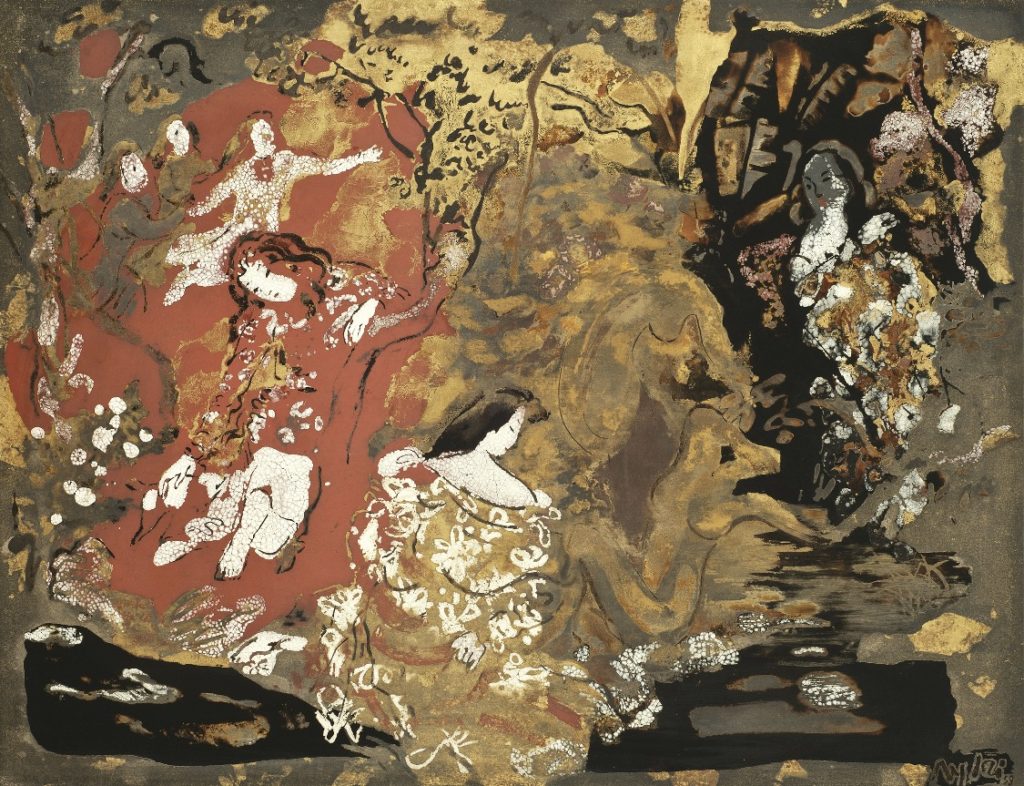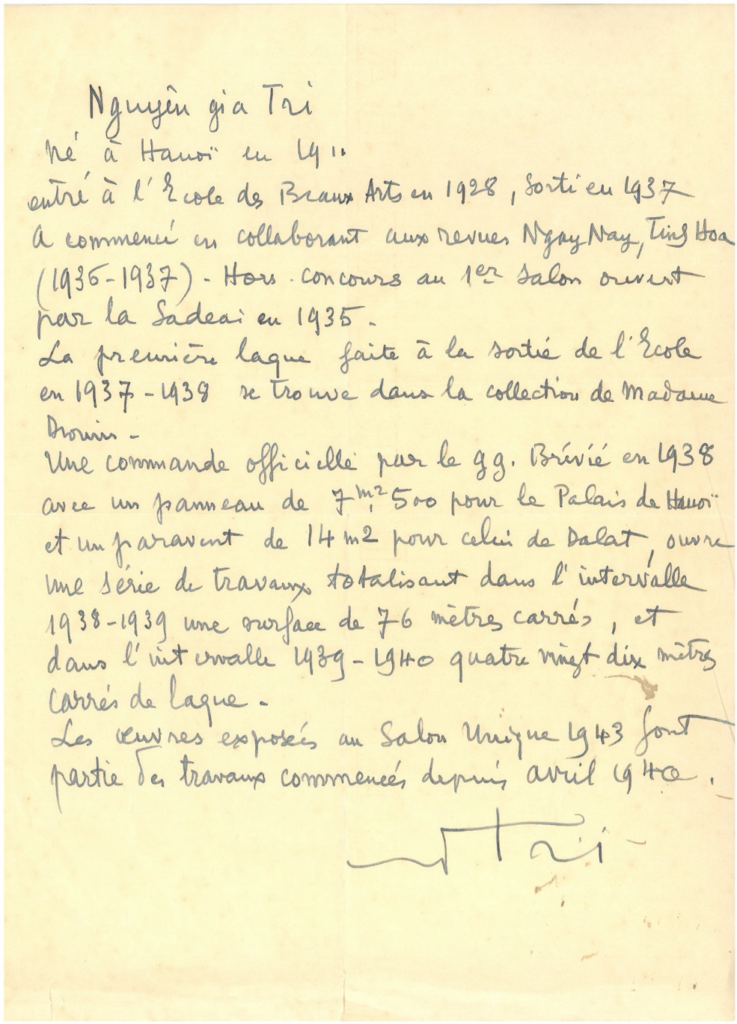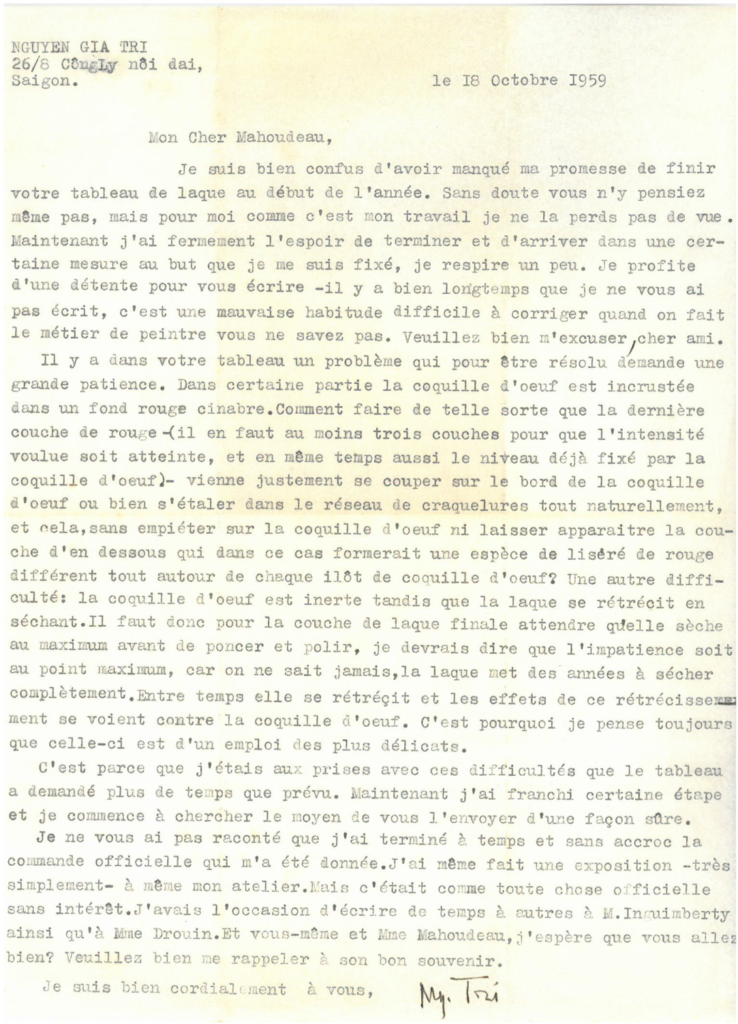Nguyen Gia Tri – « La perfection ou femmes et jardins du Vietnam »
Born in 1908 in Hadong, near Hanoi in northern Vietnam, Nguyen Gia Trí, the leading artist in Vietnamese lacquer, is not only a perfect practitioner of the art, but also an exacting theorist. His life epitomizes the artistic and political story of modern 20th century Vietnam. To apprehend a work of Nguyen Gia Trí is to be immersed in the enduring elegance and beauty of Vietnam, and be absorbed by the country’s inspiring history.
A masterpiece is invariably always created as a result of a brilliant artist encountering a situation of great particularity. In the face of exceptional circumstances, the talent of an artist is distilled and brought to the fore.

La perfection ou femmes et jardins du Vietnam (Perfection or Women and Gardens of Vietnam) was conceived exactly 16 years before it was finally completed in 1959. In Hanoi in 1943, Nguyen Gia Trí met a highly regarded art critic, Claude Manoudeau, during the Salon Unique where the top artists of the time were selected to exhibit.
In 1928, Nguyen Gia Trí entered the École des Beaux-Arts de l’Indochine founded by Victor Tardieu. Nguyen Gia Trí left the college unexpectedly in 1930, leaving not only his kindred classmates, but also teachers like Joseph Inguimberty, who headed the painting department from its very inception till 1945, and whose greatest legacy is possibly his encouragement of his students to experiment with lacquer as a fine art painting medium. By leaving the École des Beaux-Arts de l’Indochine, Nguyen Gia Trí was also giving up the opportunity to participate in group exhibitions at the college, which always attracted an influential, cultured audience.
Nguyen Gia Trí had become a member of the VietNam Quoc Dan Dang (VNQDD), the Vietnamese National Party. On 10 February 1930, there was a mutiny in Yên Bái, a province in Northern Vietnam. This was an uprising of Vietnamese soldiers in the French colonial army, together with civilian supporters from the VNQDD. It was the largest revolt yet against French colonial rule in Vietnam. Following the mutiny, in keeping with the spirit of his resistance to the French administration in Vietnam, Gia Trí decided to renounce all French influence in his life. It was this conviction that precipitated his departure from the college that had been set up under the auspices of the French Governor-General of Indochina. Eventually, it was Victor Tardieu, the director of the college and an artist himself, who persuaded Gia Trí to see that his obligations as a patriot should not stand in the way of his art. And so it was that in 1931, Nguyen Gia Trí rejoined the college to finish his diploma in 1936, along with Tran Van Can and Luu Van Sin.
After graduation, Gia Trí became part of the Tu Luc Van Doan (Self-Reliance Literary Group), a literary movement that produced poetry and prose shaped by nationalist and anticolonial sentiments. Gia Trí contributed to two magazines, Phong Hoa (Customs) and Ngay Nay (Today), which attracted a wide readership.
In the first art exhibition organized by the Société Annamite d’Encouragement à l’Art et à l’Industrie (SADEAI), the Annamese Society for the Support of Art and Industry, founded in 1935, his works were second to none, and made a big impression. In 1938, he obtained his first official commission from the Governor-General Brévié, to decorate his palace in Hanoi, the present-day residence of the President of the Socialist Republic of Vietnam.
In 1943, he exhibited in the art exhibition, Salon Unique. The review of the exhibition by Claude Mahoudeau captured the strong impression that Nguyen Gia Trí made:
Here at the front of the room are the lacquers of Mr. Nguyen-Gia-Trí. We have the good fortune to come across a passage written by the Goncourt brothers that could well have been for these lacquers:
‘He has redefined grace…, this grace is the little something that clothes a woman of charm, of coquetry, of a beauty beyond physical beauty. This grace is a subtlety that resembles the smile of a line, the soul of a form, the spirituality of an object. All the seductions of the female at ease, the langour, the idleness, the strut, the lengthening, the nonchalance, the cadence of the poses, the suppleness of the feminine body and the play of the slender fingers on the grip of the fans.’
There is nothing left to do but admire the creations of an artist whose contribution to this exhibition is considerable. The artist’s works dazzled everyone.”

Claude Mahoudeau and Nguyen Gia Trí’s friendship continued to blossom. the relation deepens in a friendship. Gia Tri had prepared and given his curriculum vitae to Mahoudeau in an envelope with his own name and address in Hanoi ready to use in order to facilitate contact with Mahoudeau.
In 1943, Claude Mahoudeau then placed an order for a special lacquer, the present lot, La perfection ou femmes et jardins du Vietnam, where all of Nguyen Gia Tri’s talent for lacquer painting would culminate in an extraordinary work. Yet in the ensuing decade, various events delayed Gia Trí’s completion of the masterpiece for Mahoudeau; tragedy of war, the war for independence, the isolation in Hong Kong, the separation of North and South Vietnam.
But eventually, the artwork was completed in 1959. In his letter to Claude Mahoudeau about his lacquer painting, Nguyen Gia Trí gave him insight into the lacquer painting process :

« There is in your painting a problem that can be resolved but only with great patience. In certain parts of the painting, the broken egg shells are encrusted in a background of vermillion red. To achieve the desired intensity of this colour, at least three layers are applied. The challenge is to make sure that the last layer of colour, applied when the egg shells are already inlaid in cavities carved out in the lacquer, only just coats the edge of each of the broken egg shells or is at least evenly spread over the web of cracks formed by the egg shells. It will not do to have this final layer produce a border of a visibly darker shade of red and form a ring around each piece of the broken egg shell.
Another difficulty: the lacquer shrinks on drying while the egg shell does not. There is thus a need for the final layer of lacquer to dry as much as possible before the painting is sanded down and polished. I have to stress that impatience will be at a high, as one never knows when the lacquer will dry completely it could take years. As time goes by, the lacquer will shrink, and the effect of this contraction can be seen against the egg shells. This is way I always think that the use of egg shells on lacquer is an extremely delicate operation. »
Indeed, the lacquer painting process is a laborious one, involving the application of multiple layers of coloured and clear lacquer, and waiting for each layer to dry before applying the next. After all the layers are applied, the artist then uses fine sandpaper, along with charcoal powder and human hair, to carefully rub at different parts of the painting to obtain the desired colour in each.
La perfection ou femmes et jardins du Vietnam is a masterwork bathed in a semi abstract atmosphere, with an explosion of gold, cinnabar red and egg shell white in a mix of matte and gloss held together by very smooth lines to set his subjects in a floating ethereal world. Another exceptional feature of this true master piece is the very unusual handwriting used for his signature as an expression of great fulfilment.
Specially created for his close friend, Claude Mahoudeau, La perfection ou femmes et jardins du Vietnam is a true manifesto of excellence by Nguyen Gia Tri, whose innovation in lacquer established for him a place of significance within modern Vietnamese art history.
Jean-François Hubert